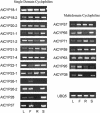The Arabidopsis cyclophilin gene family
- PMID: 15051864
- PMCID: PMC419803
- DOI: 10.1104/pp.103.022160
The Arabidopsis cyclophilin gene family
Abstract
Database searching has allowed the identification of a number of previously unreported single and multidomain isoform members of the Arabidopsis cyclophilin gene family. In addition to the cyclophilin-like peptidyl-prolyl cis-trans isomerase domain, the latter contain a variety of other domains with characterized functions. Transcriptional analysis showed they are expressed throughout the plant, and different isoforms are present in all parts of the cell including the cytosol, nucleus, mitochondria, secretory pathway, and chloroplast. The abundance and diversity of cyclophilin isoforms suggests that, like their animal counterparts, plant cyclophilins are likely to be important proteins involved in a wide variety of cellular processes. As well as fulfilling the basic role of protein folding, they may also play important roles in mRNA processing, protein degradation, and signal transduction and thus may be crucial during both development and stress responsiveness.
Figures




Comment in
-
Introducing immunophilins. From organ transplantation to plant biology.Plant Physiol. 2004 Apr;134(4):1241-3. doi: 10.1104/pp.103.900108. Plant Physiol. 2004. PMID: 15084722 Free PMC article. No abstract available.
References
-
- Albà MM, Pagès M (1998) Plant proteins containing the RNA-recognition motif. Trends Plant Sci 3: 15–21
-
- Anderson JM (1986) Photoregulation of the composition, function, and structure of thylakoid membranes. Annu Rev Plant Physiol Plant Mol Biol 37: 93–136
-
- Arabidopsis Genome Initiative (2000) Nature 408: 796–815 - PubMed
-
- Arpagaus S, Rawyler A, Braendle R (2002) Occurrence and characteristics of the mitochondrial permeability transition in plants. J Biol Chem 277: 1780–1787 - PubMed
-
- Azevedo C, Santos-Rosa MJ, Shirasu K (2001) The U-box protein family in plants. Trends Plant Sci 6: 354–358 - PubMed
Publication types
MeSH terms
Substances
Associated data
- Actions
- Actions
- Actions
- Actions
- Actions
- Actions
- Actions
- Actions
- Actions
- Actions
- Actions
- Actions
- Actions
- Actions
- Actions
LinkOut - more resources
Full Text Sources
Molecular Biology Databases
Research Materials

